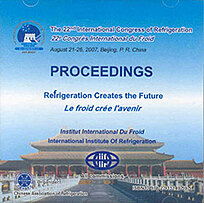
Document IIF
Analyse de la dynamique des systèmes sur la consommation d'énergie et l'impact sur l'environnement du conditionnement d'air des immeubles civils à Shanghaï.
System dynamics analysis on energy and environment demands of air conditioning in civil buildings in Shanghai.
Auteurs : BAI W., LONG W. D., LIU Z. Y.
Résumé
Shanghai has not its own energy resources and has to obtain from other provinces, cities and countries. Along with people's living standard and economic developing rapidly, the total energy consumption amount grows and energy situation becomes very tense and severe in Shanghai year by year. So increase of energy demand of civil air-conditioning and the following environment demand should be paid attention to in the future. This paper builds system dynamics models and makes three scenarios to analyse the energy and environmental demands of civil air conditioning in Shanghai in the next 15 years. Both residential air conditioner and air-conditioning system in commercial buildings are considered. Results show that if Shanghai develops according to the mode of Scenario A, it would encounter very severe energy crisis in the future, even baffle socio-economic development. But if according to the mode of Scenario C, it would reach the planning goal of Shanghai and realize the sustainable development of energy and environment smoothly.
Documents disponibles
Format PDF
Pages : ICR07-E1-1155
Disponible
Prix public
20 €
Prix membre*
Gratuit
* meilleur tarif applicable selon le type d'adhésion (voir le détail des avantages des adhésions individuelles et collectives)
Détails
- Titre original : System dynamics analysis on energy and environment demands of air conditioning in civil buildings in Shanghai.
- Identifiant de la fiche : 2008-0827
- Langues : Anglais
- Sujet : Environnement
- Source : ICR 2007. Refrigeration Creates the Future. Proceedings of the 22nd IIR International Congress of Refrigeration.
- Date d'édition : 21/08/2007
Liens
Voir d'autres communications du même compte rendu (839)
Voir le compte rendu de la conférence
Indexation
-
A simulation-based study of model predictive co...
- Auteurs : LI P., BARIC M., NARAYANAN S., et al.
- Date : 16/07/2012
- Langues : Anglais
- Source : 2012 Purdue Conferences. 2nd International High Performance Buildings Conference at Purdue.
- Formats : PDF
Voir la fiche
-
What have we learned from field demonstrations ...
- Auteurs : KHABBAZI A. J., PERGANTIS E.N., REYES PREMER L. D., LEE A. H., MA J., LIU H., HENZE G. P., KIRCHER K. J.
- Date : 15/07/2024
- Langues : Français
- Source : 2024 Purdue Conferences. 8th International High Performance Buildings Conference at Purdue.
- Formats : PDF
Voir la fiche
-
Design and experimental performance of practica...
- Auteurs : HAM S. W., KIM D., PAUL L.
- Date : 15/07/2024
- Langues : Anglais
- Source : 2024 Purdue Conferences. 8th International High Performance Buildings Conference at Purdue.
- Formats : PDF
Voir la fiche
-
VENTILATION COOLING OF RESIDENTIAL BUILDINGS.
- Auteurs : KAMMERUD R.
- Date : 1984
- Langues : Anglais
Voir la fiche
-
Experimental demonstration of model predictive ...
- Auteurs : LI P., LI D., VRABIE D., et al.
- Date : 14/07/2014
- Langues : Anglais
- Source : 2014 Purdue Conferences. 3rd International High Performance Buildings Conference at Purdue.
- Formats : PDF
Voir la fiche
